Performer Flying: Difference between revisions
| Line 46: | Line 46: | ||
===Flying Snake=== | ===Flying Snake=== | ||
Kaa the snake in [[The Jungle Book]] made her first entrance by genie trap. The performer, Caroline Denis, had done aerial work in the past. It was suggested by Hugh Hodgart the director that show make an entrance by appearing above the stage on aerial silks. Once in discussion with [http://aerialedge.co.uk/ Aerial Edge] the circus school in Glasgow it was quickly decided that this would never be a safe trick even if the performer was a professional silks artist, which she was not. As this idea had been brought up after the final costings had been submitted, we could not afford the cost of 200 GBP for aerial silks. It was decided instead to fake the trick using a tumble [[harness]] and a piece of fabric. | |||
[[File:jbsnake.png|400px|thumb|centre|First sketch of the desired trick sent to [http://aerialedge.co.uk/ Aerial Edge] before the harness was used. ]] [[File:JBsnake2.png|400px|thumb|centre|Rigging for the silk. This was eventually taken out part way through performances as the performers coat hanger caught on top of the batten causing it to jolt as the performer was flying in. It was instead tied in a knot and stropped to a karabiner. ]] [[File:jbsnake3.jpg|400px|thumb|centre|Flying session with Mark from [http://aerialedge.co.uk/ Aerial Edge] to fake a silk trick. ]] | |||
Click [https://www.youtube.com/watch?v=3RYqu3n9Ax0 here] to see a video showing the evolution and a breakdown of what happens backstage during a show of this trick. | |||
===Health and Safety=== | ===Health and Safety=== | ||
Revision as of 22:06, 5 January 2018
The Jungle Book 2017
The Jungle Book was the Christmas show of 2017. There were 2 main performer flying sequences. The first one was a monkey to enter from SL fly in to centerstage and take Mowgli out to SL. The second was for Kaa the snake to enter centerstage on aerial silks. In consultation with Aerial Edge
Click here [1] to see the first (mini) test video of the Flying Monkey track system.
Overview
The performer flying gear was set up on a table in the SL wing. We used a setting list to ensure everything was in place pre-show.
We had a particular check list for the performer flying in addition to the pre-show check list. One of these was filled out and signed every day. The completed lists were kept in the TSM Master folder. The checks in the morning took roughly 20-30 minutes to complete. The checks were done and hour before the hour call in order to leave room to fix any issues that may arise. 50 kg in the form of stage weights were put on each line every morning and we ran the flying monkey sequence from beginning to end.
As part of the pre-show checks we needed to check the rigging of the automation. In order to keep the checklist concise this document with a detailed explanation of each element of the termination on the automation line. This and all paperwork was kept printed in a folder on the TSM table in the SL wing. This also included a copy of every crew members running list, so theoretically someone could run the show off that folder. A TSM prompt copy if you will.
Along the same line of the Automation Rigging Document, a document explaining the elements and maintenance of the harnesses should let someone perform harness checks after reading this document.
The harness checks were done daily and there was also a reminder for fitting the harness on the performer. The performers became very comfortable with putting the harnesses on. By the time it got to shows it was a matter if handing the performer the harness in the correct orientation. The performer would then go and get the harness ready. The TSM or DTSM would hold each side connection point on the performers hips. There would be a verbal check that the performer is comfortable with the placement of the connection point. The performer would then tighten the legs and the TSM or DTSM would tighten the front webbing and perform all checks specified on the harness check lists.
Rope Swing
The rope swing was an idea that came about at the white card. It was initially supposed to be hanging off one of the pillars SL. This was quickly vetoed as that was more work that it was worth for workshop to build a pillar to support a rope swing for one simple trick. it was then talked about having the rope hang from a fixed point in the grid and be pulled and dropped from Prompt side flys. This was not a great solution since the trajectory of the rope Hugh Hodgart wanted was quite wide and could not be achieved from a fixed point without a very tall starting platform offstage and then there was the concern of the safety of the performer while landing. The only solution at this point was a compromise. We would use the performer flying automated track to "fake" a swing therefore making it a safer landing and Hugh would get a longer "swing" but only on one plane. The swing itself was initially tried with an upside-down TSM show box. This proved not to be high enough so we graduated to a small set of 3 treads. The trick still lacked the "oumph" Hugh wanted from the swing. The solution was for the performer to take a verbal GO from the TSM who would hear the automation cue called and be able to watch the track and give a go to the performer when the carrier had moved onstage enough that there would be an adequate amount of swing in the rope but not too much it made it unsafe for the performer to land. This was a matter of counting 2-3 seconds and giving the performer a verbal go.
Here is a link to a video showing the evolution of the Rope Swing and a breakdown of what is going on backstage and the final trick.
Flying Monkey
The brief for the flying monkey came back as far as the white card meeting. It was initially the idea to have the monkey fly in from SL, grab Mowgli and then both fly out to SR. This changed once Hugh the director got involved and he decided it made more sense for the Monkey and Mowgli to go back in the direction the monkey came from. It was also decided that Monkey would not grab Mowgli and it would be more of a "suggestion" of luring Mowgli to the Banderlog.
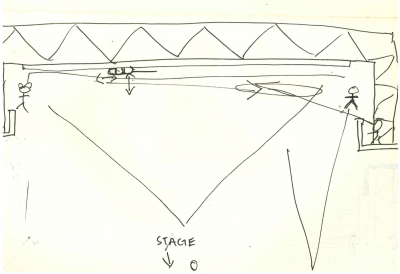

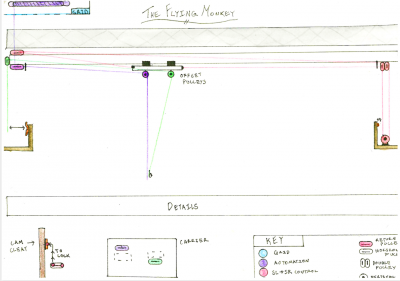
Click here for a video of the load testing of the system before putting people in it. Click here to see a video showing a breakdown of what's happening backstage during the performance.
Flying Snake
Kaa the snake in The Jungle Book made her first entrance by genie trap. The performer, Caroline Denis, had done aerial work in the past. It was suggested by Hugh Hodgart the director that show make an entrance by appearing above the stage on aerial silks. Once in discussion with Aerial Edge the circus school in Glasgow it was quickly decided that this would never be a safe trick even if the performer was a professional silks artist, which she was not. As this idea had been brought up after the final costings had been submitted, we could not afford the cost of 200 GBP for aerial silks. It was decided instead to fake the trick using a tumble harness and a piece of fabric.
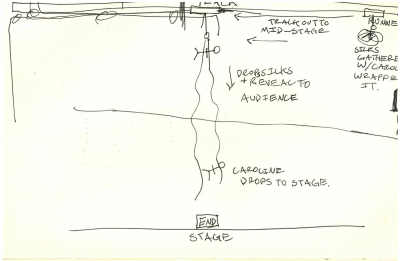
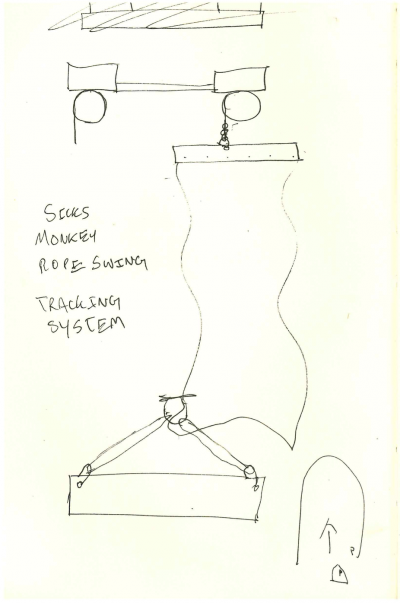
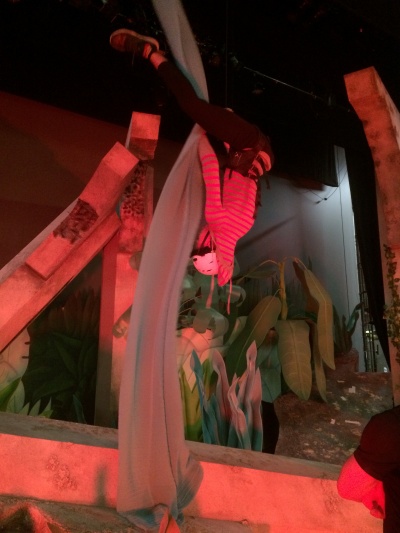
Click here to see a video showing the evolution and a breakdown of what happens backstage during a show of this trick.
Health and Safety
The tricks performed were covered by 3 non generic Risk Assessments written specifically for the show. Copies of these can be found below, RA for performer flying with bump caps, RA for performer flying w/o bump caps and an RA for the rope swing.
With any performer flying there must be rescue plans and back up plans if the flying fails or the performers are uncomfortable. The rescue plans are shown below. The tallescope rescue did have to be used the first time we ran the Flying Monkey sequence with people in the rig. A change to a cue by a couple seconds caused the automation line termination to run into the pulleys. Luckily it was crew members in harnesses and they remained calm and brought themselves into the tallescope basket. Copies of these rescue plans were kept in the TSM Master folder on the TSM table SR.
The signal that was created if the performers were uncomfortable in the air or if the system did not work was in BSL since one of the performers was from the BA Performance in BSL Course. The sign translates to "Sign B", similar to Plan B but faster to sign in an emergency.
More information about Suspension Trauma follow the links below:
3. Video
